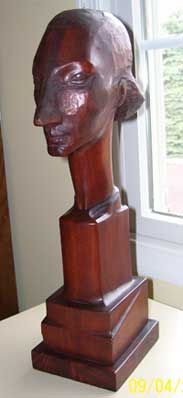About a year ago, I wrote a blog post about a sculpture that was displayed at the 1939 New York World’s Fair by artist James House Jr. A reader recently wrote me about two pieces of House’s sculptures that he owned.
One piece was signed by House, but the other was not, even though it resembled his work, according to the reader. House was a Philadelphia artist whose medium was wood, and he was also a caricaturist who worked for several newspapers and magazines. I asked the reader to send me photos of each piece.
Each Friday, I answer readers’ questions about items they own, helping them in researching the history and directing them to resources to determine value. Today, I’m reviewing these sculptures.

Question:
I have a sculpture signed by James House 1930-31. I was told it was used in a vestibule in a home in Philadelphia to put hats on. I also have one not signed. I think it is also by House. I would like to know what value they may have.
Answer:
I could find only two James C. House Jr. sculptures sold on the web, and one was from the auction I attended in 2011. It sold at that Philadelphia-area auction house for $3,000. The sculpture, according the auction-house description, had a pedigree and provenance, and it was more than 7 feet tall.

The piece – a wooden nude female signed “James House Jr. 1935” – had a paper tag attached to its leg noting that it had been exhibited at the 1939 New York World’s Fair. I could not find anything about the sculpture on the web. But artwork was apparently commissioned by organizers and companies for the fair.
Here’s how it was described on the auction sheet:
James House Jr. Monumental Carved Wood Sculpture. Female Nude. Exhibited at 1939 World’s Fair. Signed near foot; 1935. Base marked Studio H.E.W. – O.V.B. Dimensions: H: 87 inches. W: 36 inches. D: 23 inches. Condition: Some splits & cracks to wood. Losses around base.
The piece had been estimated at $1,500 to $2.500. The bidding got started at $750.

There’s no way to know if your pieces will bring in the same amount of money. What an item is worth depends on who’s looking for it at a given time and how much they’re willing to pay for it, among other factors, including the rarity of the item and the notoriety of its maker.
Since House signed two of his pieces in the same way, I wonder if your third sculpture of the man is actually one of his. Artists do sometimes sign some works and not others, but House appeared to be consistent in his signature and his style of signing pieces.
That’s why it’s a good idea to have a reputable gallery or auction house in your city to take a look at the pieces, since House is a “listed” artist, one whose works are recognized.

Some of the larger auction houses have free appraisals or reduced-price-appraisal days where they’ll give you an eyeball estimate of value. Their experts sometimes have access to resources that are not readily available on the internet or the houses may have art experts on their staffs.
You can find auction houses in your area by using auctionzip.com and writing in your zip code. A list of auction houses in your area will come up along with their websites. Google a few to check them out and to see if they offer free appraisals.
Heritage Auctions in Dallas has a form on its site for free evaluations of your items. Freeman’s Auctioneers and Appraisers in Philadelphia also does estimates for consignments, if you send an email with info & photos of the item. These are just two; there are others nationwide.

Please take a look at this blog post I wrote with some research tips you can do on your own.
I found on the web only three other examples of works credited to House: a caricature, an abstract sculpture from 1947 and an illustration for a 1959 cover of the University of Pennsylvania Museum of Archaeology and Anthropology’s Expedition magazine. It was a color drawing of Tiwi burial poles to accompany an article he had written called “Tiwi Burial Poles as Sculpture.”
If you have more information that can help this reader, please write me in the Comments box below.
